tri-Ace’s Valkyrie Profile is weird even by JRPG standards. It throws out nearly every genre convention in order to tell the Norse story of Ragnarok in RPG form, much though it may deviate from the source material. The valkyrie Lenneth must prepare Valhalla for cataclysmic war by recruiting the worthiest dying mortals to serve as divine soldiers (einherjar): therefore there is a limit on the player’s activities before Ragnarok – the endgame – begins, and those activities consist of visiting einherjar at the moment of their tragic demise, then delving into dungeons to level them up before sending the most heroic to Valhalla, never to return.
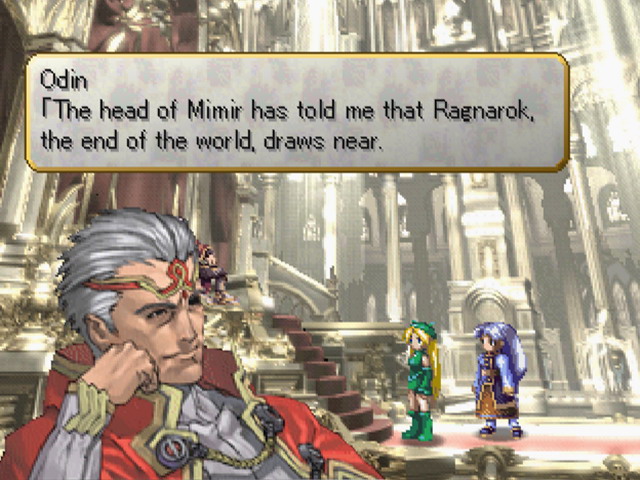
Everything that you do in Valkyrie Profile follows from this premise. (All Valkyrie Profile images via yannick.fleurit.free.fr)
Although some of the einherjar’s stories are interconnected, they have little to no story role as soon as they become party members. The bulk of the game’s storytelling occurs in disjointed vignettes that establish the tone of the setting but don’t give you much reason to get attached to specific characters – which is just as well since you have to let a good number of them go in order to fulfill Odin’s demand for recruits. You’re free to view these scenes in any order, though only a few are revealed during each of the game’s eight chapters. At the end of each chapter you’re shown how the quality of the einherjar you transferred affects progress in the Valhalla war effort, as well as the bonus you receive from Odin. All of this combines to create a game with a very specific mood and a very circumspect story. Lenneth is more or less defined by her job, and the particulars of how she does it have a gameplay impact but are mostly irrelevant to how Ragnarok unfolds.
…at least, that’s the case if you get the “B” ending. If you notice an odd feature of the status menu, if you piece together vague references in certain characters’ dialogue, if you do the exact right thing in the exact right place at the exact right time – in other words, if you use a walkthrough – you can instead trigger the “A” ending, which reveals the true nature of Lenneth and gives her a real character arc. Almost the whole of the game’s actual plot, the stuff that would be doled out in cutscenes every 30 minutes in Final Fantasy, is locked behind an incredibly arcane puzzle that demands counterintuitive actions at extremely specific moments spread out over the course of a 30-hour game – which boils down to tri-Ace doing for storytelling what it normally does for game mechanics.
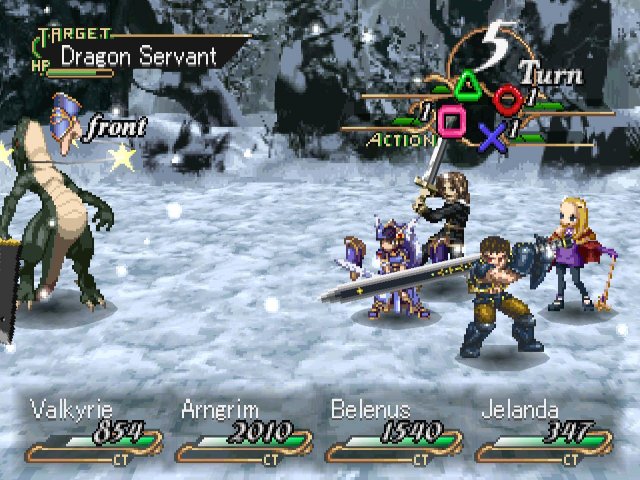
Valkyrie Profile combat looks turn based until you press a button, and then things get craaaaaaazy.
VP’s battle system bears more resemblance to Marvel vs. Capcom than to Final Fantasy. Your party chains attacks together into combos, which need to be carefully timed just as in a fighting game – e.g. a low attack will miss if the target has just been launched into the air. Juggling enemies yields experience bonuses; pounding an enemy that’s been knocked down reduces the cooldown on special attacks. Those special attacks can only be used after a combo long enough to fully charge the special attack meter, but multiple specials can be chained together if used in the correct order. You’re rewarded for experimenting with the composition of your party, the order in which their three attacks are used, and the order you send them into a combo. Unfortunately, once you’ve found a pattern that lets you chain as many attacks as possible, you are rarely forced to switch it up; aside from a few enemies with small hitboxes, your technique will be universally applicable. Strategy boils down to choosing the order in which you’ll beat down on enemies – especially important in some Hard mode battles where enemies can revive each other or absorb the strength of defeated comrades – and when to give up a character’s turn to use healing items or spells.
Despite the dynamic feel of combat, it quickly becomes repetitive, so it’s good that most non-boss enemy encounters can be avoided while exploring dungeons. Exploring in VP means 2D platforming, rather than the usual maze running. Combat is initiated by touching an enemy, and it’s usually not very difficult to play keep-away if you don’t feel like fighting. Enemies don’t respawn until you leave a dungeon entirely – and since re-entering a dungeon advances the Ragnarok clock, this ensures that the experience you need to prepare yourself and your einherjar for the endgame is a limited resource. The other major mechanic in the exploration phase is Lenneth’s ability to shoot crystals which can stun enemies or create platforms. The dungeon design gets a lot of mileage of this twist, but overall the platforming in VP is at best a novelty and at worst a frustrating mess – most of the dungeons exclusive to Hard mode have some kind of gimmick that is far too demanding for the sloppy jumping physics you have to work with, and failing often means being sent back to the beginning, or even being kicked back to the world map, pushing the clock forward and most likely causing you to reload your save.
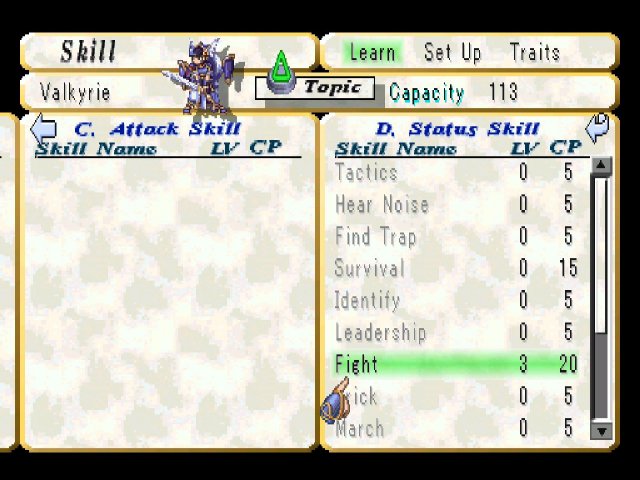
Most of these don’t do what they sound like they should do. Some don’t do anything.
tri-Ace loves giving you a huge list of skills to choose form when developing characters. In VP, many of those skills don’t have any effect in battle, but are instead used to assess the capability of einherjar sent to Valhalla. The distinction isn’t always clear, either – Find Trap will not show you traps in dungeons, of which there are plenty, but an einherjar sent to Valhalla with Find Trap will occasionally get an award for detecting a trap. Hooray! But that’s nothing compared to the opacity of the Transmutation system that converts one item into another – or maybe a third or fourth type, if you have the right item equipped… one of which you create by transmuting something else… again, the sheer possibility space means you’ll be using a walkthrough. And if you use transmutation to its fullest potential, you end up with equipment that frankly breaks the game, even on Hard difficulty.
So Valkyrie Profile sets itself apart from other JRPGs in nearly every aspect of its design and execution. Not all of those differences are for the better, but when it fails, it fails with character. Six years later, tri-Ace released Valkyrie Profile 2, which took the essential mechanics of the original and transplanted them into a much more conventional, and much more polished, JRPG. The narrative conceit of Ragnarok’s impending arrival, and the game structures built around that premise, are entirely absent: VP2 follows a party of eccentrics on a linear quest to find a MacGuffin, traveling from town to dungeon to town, resting at inns, buying items from shops with money, and advancing the story through a steady trickle of cutscenes, like every other JRPG. Transmutation is gone, and there is only one end to the story. Einherjar can be collected in dungeons (with only a brief line of dialogue to establish them as characters) and released after leveling up, but the reward is merely a stat-boosting item. Many character skills are available, but all have a clearly defined purpose, though many are highly situational.
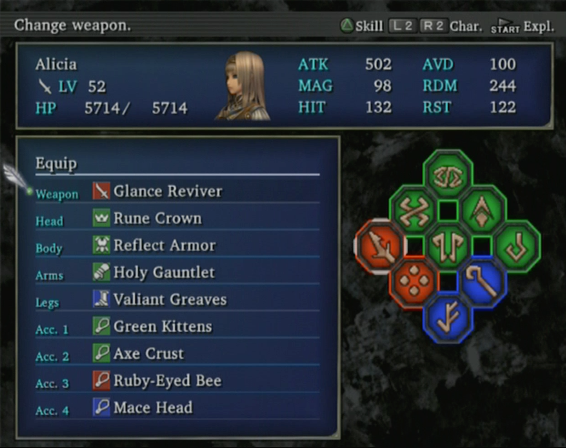
The sequel is a prettier game, and it’s not always just about polygon count – like the visually pleasing rune mechanic that unlocks new skills.
None of this is to say VP2 is simplistic or unoriginal. Skill acquisition by equipping items is a common trope, but here a combination of items in adjacent slots on a grid is required to unlock each skill. While this could have been an overwhelming combinatorics problem, giving each item one of four colors and limiting each skill to a color-matched set gives the player a friendly visual handle on the possibility space, and the equipment grid is a very pleasant piece of user interface design. Monster parts can be sold to stores to craft powerful items and equipment, but how those parts are obtained is married beautifully to the unique Valkyrie Profile style of combat (more on that later).
One of VP2’s most unique additions is the ability to collect and manipulate Sealstones, which create dungeon-wide effects on the party and enemies. This single mechanic enables not only some very clever puzzle designs in dungeons but also another layer of player customization that gently ramps up in complexity over the course of the game as more sealstones come into your possession and more of them can be equipped at once. (Among the few bits of unfortunately opaque design in VP2 is that those slots are gained by completing optional dungeons which only appear if you talk to certain random NPCs, and sometimes talk to them more than once; NPC interactions are otherwise totally disposable, so it’s easy to miss these very important rewards.)

The Sealstone system will throw a new set of variables at you in each new dungeon, and then let you customize those effects to your taste.
The pieces of Valkyrie Profile that survive in VP2 are the platforming dungeon sequences and the basic fighting-game-y combat mechanics, but each of those elements is refined and elevated here. The feel of VP2’s dungeon exploration is terrific, and even though the platforming is much improved, the finicky twitch-based jumping puzzles are gone, just to be safe. Replacing Lenneth’s crystals are new protagonist Alicia’s photons; these let Alicia jump on floating enemies by freezing them, in the finest tradition of Samus Aran. Even better, a second photon fired at a frozen enemy swaps its position with Alicia’s, opening up a whole new set of possibilities for platforming puzzles, not to mention lightning-fast movement across areas you don’t feel like fighting in. Getting all the treasures in each dungeon usually requires some very creative use of photons, though the item you get is usually less satisfying than the feeling of accomplishment. Yggdrasil, the third-to-last dungeon of the game, is a brilliant challenge that melds platforming, photons, and sealstones together in a completely new and intuitive way.
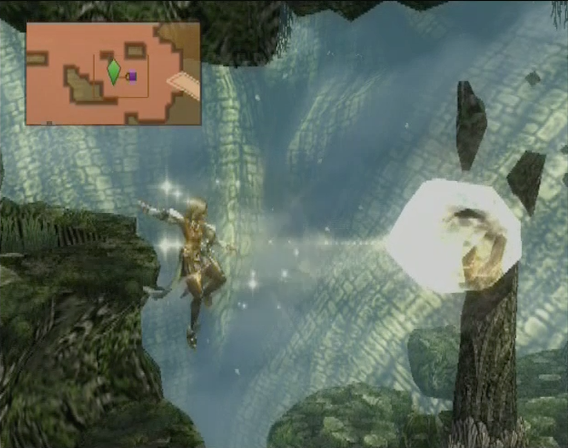
Alicia can not only freeze enemies to create platforms but also switch positions with a second hit.
The improvement to dungeon exploration would have been enough, but VP2 also pushes the original game’s combat forward by literally adding a new dimension. Battles take place in an arena which the party must traverse to reach enemy targets. Enemies can attack if the party steps into their target range, a visible cone or circle on the map. Enemies only move when the party moves, but the party can also dash to pass through a danger zone unscathed, at the cost of Action Points, which are regenerated by moving normally. This, in itself, is tremendous fun, and you’re incentivized to do it a lot since there is a big XP reward for heading straight for the lone enemy leader, whose defeat means immediate victory. I love the leader idea and the snappy pace of combat it allows. The faster the leader goes down, the more bonus magic crystals you get – magic crystals still being the reward for juggling enemies with a mid-air combo – and in VP2 these serve not only as a multiplier to the XP reward in battle but also, in a nice touch, as the currency used to permanently add sealstones to your collection. Although I didn’t often make use of it, there’s also the ability to split your party into two groups so the beefier characters can draw fire away from their fragile partners. So tactical movement is a crucial aspect of the new battle system, and this goes a long way toward relieving the grind of combat.
There are flaws with this system, for sure; characters will sometimes unexpectedly get stuck on geometry during a dash, leaving them right in the line of fire. The fact that enemies have multiple attacks with different ranges, and their chosen attack often changes following a player action, means a safe spot regularly becomes an unsafe spot without an opportunity to react. This is forgivable since otherwise you could probably finish 99% of battles without the enemy taking a turn, and also because you can manipulate this phenomenon to your advantage by using a menu action to force the enemy to switch to a more easily avoidable attack.
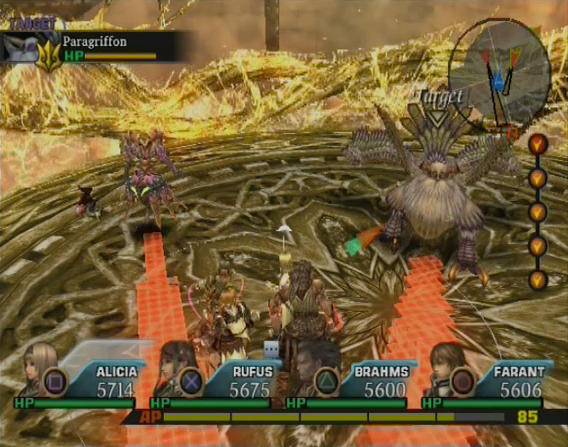
VP2 battles incorporate a mild level of tactics; stay out of the red zones and enemies can’t attack.
The battle menu is an interesting idea but definitely the one that I’m most ambivalent about. Casting non-attack spells, changing equipment, and using items all make use of the battle menu, and once any character does any of those, the menu is unusable until a cooldown period elapses. Moving, attacking, or being attacked will advance time until the menu is available again. Initially this requires judicious decisions about healing, especially in boss fights, since you’ll probably only get to use one item or spell between the boss’ big party-wide beatdowns, but that soon becomes a moot point as you accumulate enough money to have 99 heal-everybody-to-almost-full items on you at all times. Ultimately the menu limit ends up only being relevant in desperate scenarios when your party is down to one survivor and you need to slowly reverse momentum with a series of revivals and healing. In that case, having to avoid contact with the enemy for such a long time can be very challenging, but not exactly fun.
Once your party is in position and you press the first attack button, the camera switches to a side-on view and the familiar mode of combo-based combat from VP takes over. The major difference is that each attack now consumes AP, which complicates fights against enemies that can survive a single turn of all-out assault. Whereas in VP you could attack the same number of times each turn and there was rarely a reason to do less, VP2 frequently requires you to choose between attacking now with a limited AP pool or trying to move around the battlefield, putting the party at risk, to put more AP into a single combo. Or, since being attacked restores a large chunk of AP, you could just stand in front of the target and trade blows – but unless you’re doing a lot of grinding, enemies in VP2 hit rather hard.
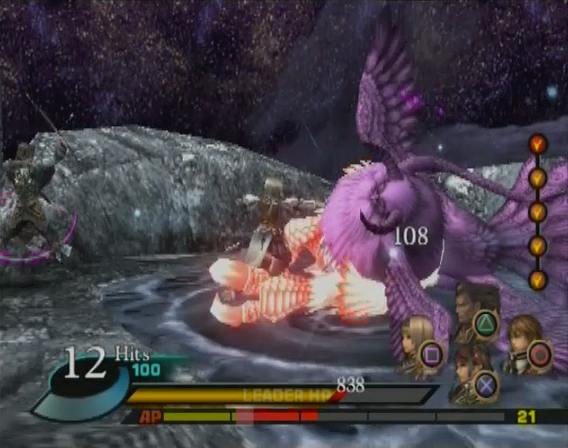
Enemies in VP2 are made up of several body parts – this attack made contact with the monster’s legs.
The other new mechanic when attacking is enemy body parts. Where you position yourself on the field in relation to the enemy, and where your attacks land, determines whether you hit their sensitive tail or their armored plating. Enough sustained damage to a single body part will break that body part off, which may yield a crafting item (told you we’d get there!) and may also activate Break Mode, a short period during which you can just button mash the enemy into paste without worrying about AP usage. Visual flourishes and some nice sound design make it viscerally satisfying when skeletons explode with goodies like an undead piñata.
Special attacks are back, and the rules for using them are the same except there is no per-character cooldown between rounds; if you’ve got the AP to get the meter to 100, you can use your specials. Blessed be tri-Ace for adding the ability to skip past the special attack cutscene that you see every single time you use it; by the end of my recent VP playthrough I was building my strategy around how to minimize the number of times per minute I had to watch them. One step backward in VP2 is that mages always have the same special regardless of the spell they have equipped, whereas in VP there was a corresponding special for each regular spell; this means if you run into a type of enemy with an elemental resistance to your mage’s special, you can’t just change spells, you have to change characters, which is something the game makes you do frustratingly often as it is.
Party management in the original VP may be odd, but in many ways it’s much friendlier to the player than a more conventional JRPG. Completing dungeons and solving puzzles rewards you with Event XP, which can then be freely applied to whichever characters you wish at your leisure. You can level up your mainstay characters faster, or – my preference – get the characters you haven’t been using up to snuff before sending them to Valhalla. It’s very nice to have that buffer rather than constantly juggling your party formation to keep everyone equally leveled. By contrast, VP2 is a downright bastard about surprising you with characters leaving your party at the whim of the story – sometimes right before tough boss fights – and instead of a bank of Event XP you get a handful of items that award a certain amount of XP to one character, that amount being insignificant by the endgame.
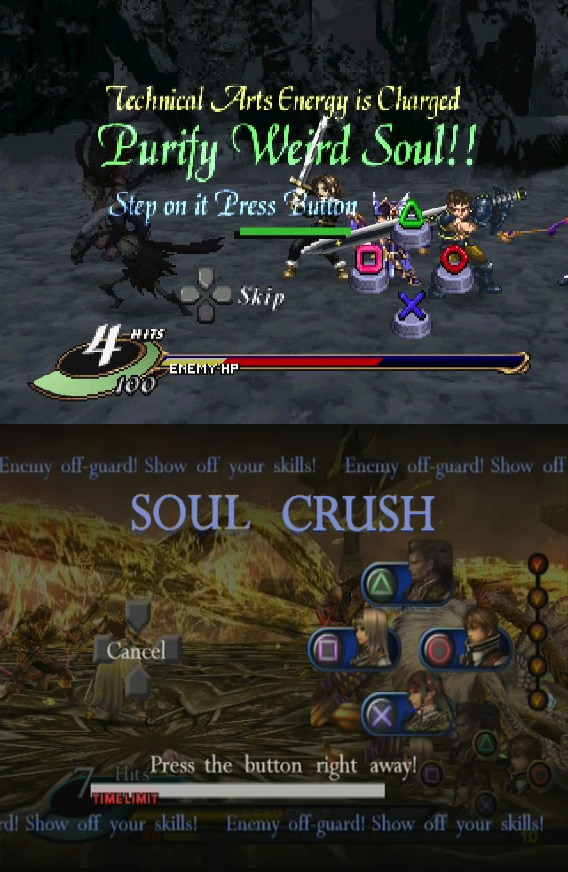
Sure, the localization is better in the sequel, but the original has so much more personality. Polish isn’t everything! …no you’re being nostalgic. Shut up.
Still, this is the only aspect of VP’s design which I would call mechanically superior to its sequel. VP2 throws as much stuff at the player but that stuff is more coherent, more polished, more balanced. There’s no doubt in my mind that in terms of mechanics the sequel is the better game.
But though I might sometimes wish otherwise, mechanics aren’t everything, and VP2’s failure to connect on a narrative or emotional level taints the whole experience. It got rid of a lot of problems the first game had, but it may have thrown the baby out with the bathwater. The countdown to Ragnarok is a compelling idea to build your game around; there is no compelling idea at the center of VP2. The dialogue in VP is stilted and the voice acting is notoriously uneven, rather behind the curve as far as turn-of-the-millenium Japanese localizations go, but VP2’s storytelling, with the benefit of improved translation and okay performances, is just incredibly boring. In terms of story, the relationship between VP and VP2 is roughly analogous to that between Chrono Trigger and Chrono Cross – the sequel takes a fairly minor unresolved plot thread and builds an entire new game out of it, more or less abandoning the theme and tone of the original, and also wreaking such havoc with convoluted time travel metaphysics shenanigans that you’re left not knowing whether anything that happened in either game ends up mattering. But Chrono Cross has its own identity independent of Chrono Trigger, and a charming one at that, while VP2 never aspires to be more than an appendix to its predecessor.
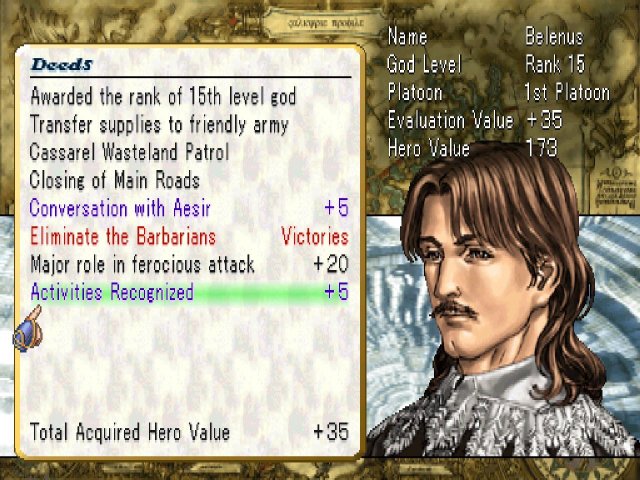
Even though this avalanche of confusing data is mechanically irrelevant, it’s all in service of the game’s core concept – that your reason for existing is to recruit einherjar to prepare for Ragnarok. Valkyrie Profile thrives on messy details like this while its sequel is very tidy and totally bland.
Valkyrie Profile’s story didn’t need a sequel (or prequel), but unfortunately tri-Ace seems unable to hold onto nice things; its flagship RPG franchise Star Ocean ended up being sunk by sequels that needlessly undermined the story its fans were invested in with retcons that made the whole setting absolutely pointless – sound familiar? Given that Valkyrie Profile 2 isn’t really about being a Valkyrie and doing Valkyrie things anymore, conceivably it could have been given a completely new setting, story and title and been just as fun without the baggage of being a sequel to a beloved game… but new IP is risky. tri-Ace’s most recent console release, excluding their contract work on the sequels to Final Fantasy 13, is Resonance of Fate, which mostly flew under the radar – despite having a terrific battle system, according to Bob Mackey on this episode of Retronauts on RPG battle systems (which you should really listen to even though it lionizes Active Time Battle more than I would). Maybe I wouldn’t have played Valkyrie Profile 2 if it didn’t have the name, and that thought makes me sad. Because it’s a great game… it’s just a lousy Valkyrie Profile.
